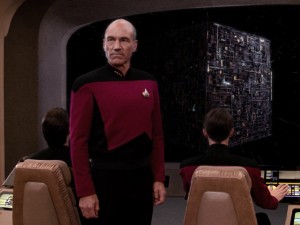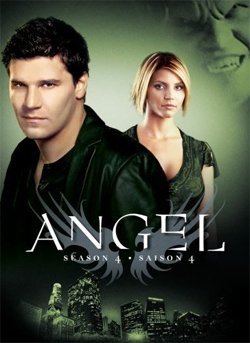“I am Locutus of Borg. Resistance is futile. Your life, as it has been, is over. From this time forward you will service us.”
“Mr. Worf: Fire.”
 Season-ending cliffhangers are now standard practice on both network and cable TV series, but in 1990, they weren’t so common, and the season finale of Star Trek: The Next Generation made jaws drop.
Season-ending cliffhangers are now standard practice on both network and cable TV series, but in 1990, they weren’t so common, and the season finale of Star Trek: The Next Generation made jaws drop.
The first part of “The Best of Both Worlds” had Star Trek fans and casual viewers wondering all summer if Captain Jean-Luc Picard would survive his assimilation by the relentless Borg, while TV critics were comparing the cliffhanger to the infamous season ender of Dallas in 1980: the mystery of “Who shot J.R.” was the most watched program in television history for its day.
TNG’s “Best of Both Worlds” remains one of the most effective season finales of any Star Trek series – arguably of any series – because it looks like there is no way out: Picard is lost; Riker will soldier on as captain of the Enterprise with ambitious newcomer Commander Shelby as his first officer.
I spent that summer wondering if Picard would return in season four. It was hard to contemplate Star Trek: The Next Generation without Patrick Stewart, especially since the series had found its creative footing in season three. The return of Gates McFadden as Dr. Crusher coupled with some great storytelling begged the question: If it ain’t broke, why fix it?
Even without the ubiquitous Internet and social media, there was chatter that Patrick Stewart was leaving the show, apparently unhappy with the series’ scripts – these rumors could be traced back to an uneven second season that was cut short by a writer’s strike. I vaguely recall reading a brief news item in Starlog magazine that fueled the fire; it also reported Wil Wheaton was leaving the series, something that did come to pass.
The late Michael Piller, who scripted the episode, made use of his own inner turmoil to drive the story as he debated whether to continue on as head of the show’s writing team; the episode became a Riker-centric story that reflected Piller’s own dilemma. (He would ultimately stay on through the end of the series, co-create Star Trek: Deep Space Nine and Star Trek: Voyager and write the screenplay for Star Trek: Insurrection).
Riker’s struggle with the prospect of promotion rings true given that he’s already turned down command twice, and it adds to the overall sense that things will inevitably change aboard the Enterprise, especially since Shelby is convinced she’s going to land the first officer’s gig.
But what really made “The Best of Both Worlds” cliffhanger so compelling was that Piller had in fact painted himself into a corner. He didn’t think he’d have to worry about solving a seemingly unsolvable problem: how to save Picard and defeat the Borg. When “To Be Continued” appears on the screen backed up by Ron Jones’ chilling music, it’s hard to imagine how the rest of the story will unfold.
Nearly 23 years later, it’s still an amazing hour of television. A feeling of foreboding hangs over the scene where Picard and Guinan discuss the tradition of a captain touring his ship on the eve of a hopeless battle and how Nelson never returned from Trafalgar, even though the battle was won.
And it even holds up well on the big screen. Last week the combined two-part “Best of Both Worlds” was shown in theatres across North America, and while the second half struggles to live up to the first (most second parts in the Star Trek universe do), as a feature film it compares well to the actual Star Trek movies. The special effects are still convincing, especially considering they were produced on a television budget with older technology, and the story slowly builds tension throughout the first half with a seamless transition into a faster paced second half.
The big screen debut of “The Best of Both Worlds” serves as a reminder that Star Trek works better on television when the characters are allowed to develop and the story lines are allowed to evolve over time. Viewed on television it is Star Trek at its finest and holds its own against big screen lens flare.
Gary Hilson is a Toronto-based freelance writer, editor and content strategist storyteller. “The Best of Both Worlds” Parts I & II is available today on BluRay as a feature-length film as is the entire third season of Star Trek: The Next Generation.
